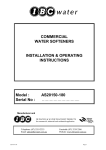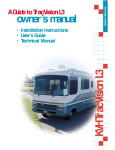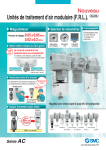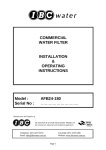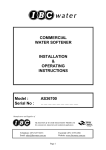Download COMMERCIAL WATER FILTER INSTALLATION
Transcript
COMMERCIAL WATER FILTER INSTALLATION & OPERATING INSTRUCTIONS Model : Serial No : AFM20-180 ……………………….. Manufacturer and Supplier of FILTRATION & WATER TREATMENT PRODUCTS for commercial, industrial and residential application Telephone: (07) 3219 2233 Email: [email protected] Facsimile: (07) 3219 2266 Website: www.ibcwater.com.au Page 1 OPERATING PRINCIPLE General Our AF Series Filters are fully automatic incorporating Backwash, Rinse-Pause, Fast Rinse and Service Cycles, controlled by cam switches in the timer. Frequency of Backwashing can be altered from that suggested in the Commissioning Section, if actual site conditions dictate alterations. Water enters the unit through the multi-port valve and passes through the media, underdrain gravel and the distributor leaving through the multi-port valve. Multi-Media Filters Remove filterable turbidity at high flow rates several times the flow rate of conventional filters, producing clear filtered water down to 10 micron through the stratified bed without chemical flocculation. No additional pumping is necessary for Backwashing, as the Backwash water required is normally only 80-90% of the service flow rate. Multi Media Filter capacity is many times that of conventional filtration due to utilisation of the entire stratified bed, resulting in low operating costs. This unit is not designed to remove colloidal matter, a plant capable of coagulation is required in such cases. Operating Parameters Water Temperature Water pH Water Pressure Oil 5ºC - 48ºC 5.5 - 9.0 205 - 690 kPa Free of Hydrocarbons AF SERIES FILTERS Table 2 TYPE MODEL MultiMedia AFM 20-180 Valve 180 Inlet (mm) Outlet (mm) Drain (mm) 40 40 40 CONTINUOS FLOW RATE L.P.M 120 PEAK FLOW RATE L.P.M BACKWASH FLOW RATE L.P.M 160 Operating Pressure: 205 - 690 kPa Temperature: 5ºC - 48ºC 114 VALVE 180 APPROX. WEIGHT KG 320 OPERATING PROCEDURES Water Temp: 5ºC - 48ºC Water pH: 5.5 - 9.0 Suspended Solids: Max 100 mg/l (Refer factory) Iron: No Effect Oil: Free of Hydrocarbons NOTE: Not recommended for Colloidal Sediment removal Electrical: 240V 50Hz 3 watts maximum Warning: A pressure reduction valve should be installed if water pressure is greater than 600kPa. Warning: A pressure reduction valve should be installed if water hammer prevails. 2 Table at left shows recommendedPage MINIMUM plumbing sizes. FAILURE TO OBSERVE WARNING WILL VOID WARRANTY INSTALLATION Check the equipment upon arrival for damage or shortages and report same to our Office or Agent before commencing installation. Locate the unit on a clean, firm, level foundation, preferably concrete, with sufficient space for operation and maintenance. Level with shims if necessary. Position the tank in the correct position before loading the Media. The filter should be fitted with inlet and outlet pressure gauges to monitor the pressure loss through the filter. It is recommended that the filter be backwashed when the pressure differential increases by 35 kPa. The control system is sometimes shipped as a sub-assembly to avoid damage in transit. The water filter should be assembled, piped and wired according to the following recommendations. The following instructions are provided as a general guide. The filter requires a 10amp 240 volt GPO. The filter installation must be protected from the elements FIG.4 - INSTALLATION -- SINGLE TANK SOFTENER INSTALLATION * Pipework Layout - suggestive only * Unit only supplied * Pipe, Valves, Solenoids, Water Meter External Backwash supplied by others Flow Controller supplied separate must be fitted before Connecting Drain Line All pipework connections to be flanged or barrel union, for ease of removal and maintenance. * USE PIPEWORK SIZES SHOWN IN PERFORMANCE DATA TABLE 2 A B C D E = = = = = Inlet Isolating Valve -- Manual Outlet Isolating Valve -- Manual Bypass Valve -- Manual - optional Water Meter - optional, fit only where metering of supply is required Solenoid Valve - optional, fit only where raw water to service is not required during REGENERATION. Valve must be 240V. 50Hz operation normally open and equal to pipeline size - connect to terminals 2 and 5 inside valve cover. Page 3 MEDIA INSTALLATION Step 1: Remove the tank and riser tube assembly from the carton and make sure the softener tank is empty and clean. Step 2: Cover the distributor pipe with a clean rag or plastic so that NO gravel or media enters the distributor pipe. Step 3: Load the media - Refer Media Placement instructions. a) Pour in the underbed gravel (No.6). Refer Table 1. 40kg. b) Level out the underbed gravel using a broom handle/PVC pipe. The underbed gravel should cover the bottom distributor by about 25mm. CAUTION: Do not raise the distributor pipe. If gravel is allowed to get under the distributor, empty and start again. c) After loading and levelling the No. 6 Gravel underbed, place the media in the tank in the correct order which is D1, D2, 7M Sand, and D3. ¬ Slowly fill the tank. Step 4: To obtain optimum performance from your unit, exercise particular care in ensuring that each grade of media is levelled evenly over the previous layer. Step 5: Fill the tank with water to 50mm from the top. Step 6: Clean top of tank (neck & threads) of all traces of media. Remove the rag or plastic fitted in Step 2, taking care not to raise the riser pipe. Step 7: Unpack the valve, remove the cap screws and separate the adaptor. Store gasket safely. Check that the tank thread ‘O’ ring and the internal Riser Pipe "O" ring seals are in place. Using a little silicone “O” ring lubricant, lubricate the outer seal surfaces only. Step 8: Fit the adaptor to the tank, carefully, to allow the distributor pipe to locate centrally. Screw down firmly by hand. Do not over tighten. Place the gasket on the tank adaptor, fit the valve body with cap screws provided. Tighten cap screws evenly. Page 4 Page 5 COMMISSIONING Step 1: Remove valve cover by partly unscrewing the three cover securing screws and lifting the cover forward. Remove the clear plastic window in the cover by removing two screws and loosening the other two screws and sliding the window out. Replace the cover on the valve. Connect the power lead to the power point and turn on the electric power. Depress the red knob (Fig. 7) and rotate anticlockwise to backwash position, release red knob. Note that the timer face design can vary between valve models from that illustrated and that the regeneration positions are indicated pictorially with Backwash being Flow shown in a Upward direction and the other regeneration positions shown with their corresponding flow path. Wait for valve drive to index to backwash position, (if not already in this position) that is the spindle is fully extended. Step 2: Just partly open inlet isolating valve. Allow unit to fill slowly (water will issue to drain) continue to run until the unit automatically indexes to the second position which is a Pause to allow media to settle. This may take up to 15 minutes and allows all the entrained air to be removed. Step 3: Depress the red knob again and rotate anti-clockwise to the fast rinse position and release. Verify that the spindle has moved to its correct position as indicated in the following illustrations. Step 4: Allow the red knob to electrically return to the service position. It is recommended to give the filter a complete backwash cycle so as to remove any dirt/colour and to further level out the media. Depress the red knob and turn anticlockwise to the start position or the first arrow position just anticlockwise from the service position then release the red knob. The unit will now go through each cycle - Backwash, pause, purge and back to service automatically, the full cycle will take approximately 30 minutes, depending on pin settings. NOTE: A small amount of media may pass to drain during the initial backwash, this is considered normal. Step 5: Check with site supervisor that unit can go on line. If so - slowly open outlet isolating valve fully, check that manual bypass valve is fully closed. This unit is now on line. Step 6: Check for and report any leaks. Go to the nearest tap, now on filtered water, open and allow to flow for a few minutes as it may take several minutes for the treated water to displace the water in the pipe system to the tap. Check for the clarity of the treated water and if unclean water persists refer to the Trouble Shooting in these instructions. Page 6 Step 7: It is now necessary to set up the Timer Control to backwash the filter automatically on specific days of the week. This is achieved by depressing pins on the Skipper Wheel relating to the days selected for the backwashing. To set the skipper wheel up as required, pull all skipper wheel pins out. Turn the dial to the correct day of the week (note dials may be indicated as the actual day of week or as numbered days of the week) on which you are setting the dial. Now depress the pins for the desired day/s for backwashing. Initially at commissioning set the filter to backwash every second day. Note when you are setting the backwashing frequency you should take into account the working days, for instance if the installation will only work week days, backwashing on the weekend would be a needless waste of water. Always set in accordance with the duty conditions for maximum economy. NOTE: This is only a guide for initial setting and should be altered to suit each individual installation in accordance with load conditions of the raw water. Step 8: Set time of day pull timer knob and set arrow to the time of day (time of your watch) note time of day may be as 12 hour or 24 hour clock, release, make sure that the knob has re-engaged gear, ie. knob right in. The filter will backwash around 2.30 AM. If it is desired to backwash at a different time it will be necessary to offset the actual time of day setting by the corresponding time difference desired for the new backwash time. Step 9: After the filter has done the first backwash and the backwash sequence and time of day has been set, turn off the electric power and remove the valve cover. Replace the clear plastic window in the cover and then replace the valve cover on to the valve and reconnect the electric power. This unit is now on line. Step 10: Do final check for leaks etc. Ensure instruction book is kept with relevant personnel Page 7 BACKWASH CYCLE TIME INSTRUCTIONS PIN TIME CHART SET TIMER Determine a regeneration schedule for the conditioner and adjust the automatic timer as follows (Reference Figures 7 and 8): 1. Pull all SKIPPER PINS out (away from control). 2. Rotate SKIPPER WHEEL until DAY ARROW points to day of week or number 1. 3. Depress SKIPPER Pin(S) for day(s) regeneration is required. 4. Pull TIMER KNOB out (away from timer face) and rotate until BLACK ARROW on tripper arm points to correct time of day on face plate. 5. Timer will automatically initiate regeneration on preset days at 2:30AM. To alter time, simply reset TIMER KNOB to an earlier or later time, which will change the time of regeneration by the same number of hours. (Time indicated as BLACK ARROW will no longer be correct). BACKWASH OR FAST RINSE NO. OF TIME PINS OUT 1 8min. 2 11 min. 3 14 min. 4 17 min. 5 20 min. 6 23 min. 7 26 min. 8 29 min. 9 32 min. 10 35 min. 11 38 min. 12 41 min. 13 44 min. 14 47 min. 15 50 min. PAUSE NO. OF PINS IN TIME 2 3 4 5 6 7 8 9 10 11 12 13 14 15 16 1.5 min. 4.5 min. 7.5 min. 10.5 min. 13.5 min. 16.5 min. 19.5 min. 22.5 min. 25.5 min. 28.5 min. 31.5 min. 34.5 min. 37.5 min. 40.5 min. 43.5 min. Each additional pin either pulled out or pushed in equals 3 minutes SET BACKWASH TIMING Pull pins as shown for desired backwash time. - See chart. SET PAUSE TIME Depress pins as shown for desired time. - See chart. (Minimum of two pins down) Figure 7 SET FAST RINSE TIME Pull pins as shown for desired fast rinse time. - See chart Figure 8 Page 8 VALVE AND CYCLE PIN POSITIONING Valve Position TYPICAL FILTER APPLICATION CYCLE Backwash ………………….. 20 min. - 5 pins outward Pause ………………………. 1.5 min. - 2 pins inward Fast Rinse …………………. 11 min. - 2 pins outward 1. BACKWASH POSITION 2. BRINE AND SLOW RINSE POSITION MANUAL OPERATION Push in RED KNOB and turn COUNTERCLOCKWISE to the START position. Release. Unit will then go through a complete regeneration as programmed. 3. FAST RINSE POSITION 4. SERVICE POSITION Page 9 ELECTRICAL DIAGRAMS Wiring Diagram440 Six-Day or Seven-Day Timer Wiring Diagram450 Impulse Timer Page 10 FLOW SCHEMATIC Page 11 REPLACEMENT PARTS Page 12 VALVE ASSEMBLY PARTS LIST Ref # 1 1034502 1034506 2 3 4 5 6 Description Part No. 1034936 1034931 1034934 1034170 1034173 1010301 1003062 1006285 1035018 1034704 1034705 1034706 1034707 1034708 1034709 Valve Body: NPT BSPP Injector Assy. "A" (Yellow) "B" (Orange) "C" (Gold) Blank (undrilled) Injector screen Injector o-ring Injector plug, ½ in NPT Cap screw, 5/16-18 x 2¾ (5 required) Gasket, Upper Cap Backwash Assembly: 4 gpm, NPT 4 gpm, BSPT 5 gpm, NPT 5 gpm, BSPT 6 gpm, NPT 6 gpm, BSPT 7 1034710 1034711 1034712 1034713 1034714 1034715 1034700 1034701 1006266 8 9 10 11 1035159 1010130 1035069 1005222 10 gpm, NPT 10 gpm, BSPT 15 gpm, NPT 15 gpm, BSPT 25 gpm, NPT 25 gpm, BSPT Open, NPT Open, BSPT Cap Screw, 5/16-18 x ¾ (4 required) Drain Shut-off O-ring Piston Assembly Cotter Pin 12 13 14 1010144 1010136 1035022 O-ring O-ring Cap 15 16 17 18 1034940 1034961 1034962 1005580 1033889 1008332 19 1005850 20 1035156 24VAC Drive Motor Assembly 120VAC Drive Motor Assembly 230VAC Drive Motor Assembly Screw, Hex Hd., 8-32 x ¾ Cam Assembly Switch (3 required) Included with item 15 Screw, Hex Hd., 10-24 x ½ (6 required0 Bracket, Switch Ref # Description Part No. 21 22 23 24 1077710 1035085 1035041 1077699 25 1078196 26 SCS-0070 27 1005585 28 29 30 1077798 1035042 1034851 Wire guide bushing, .875 Drive link assembly Gasket (valve motor plate) Nut, keps, 6-32, plated steel (4 required) Screw, Hex Hd., 10-32 x 3/8 (3 required) Screw, 6-32 x 3/8 round head (4 required) Screw, Hex Hd., ¼-20 x 3/8 (10 required) 962-180 turbine meter cable Gasket (valve to adapter Adapter kit, top mount 31 32 33 34 ORE-347 ORE-225 1077721 1034524 O-ring O-ring Cover Side Mount Adapter 962 Electronic Control Parts (Sub-Assy. P/N: 1077719) 35 107713 36 37 38 39 1076297 ZHDW4152 650022 SCS-0064 40 SCS-0054 41 42 1075767 1075721 43 44 45 46 1075768 1075764 1070488 1075766 47 48 49 1077706 1070491 1077915 Wire harness assembly PWA assembly 962 Marker strip, 11-20 10 Terminal block Screw, 4-40 x 5/8 round head (2 required) Screw, 2-56 x ¼ ph/pnhd (2 required) Battery Clip, 962 Wire harness, 10 cond., 962 Battery, NiMH, 9V, 962 (optional) Wire harness, battery, 9V Keypad, membrane, 962 Screw, 8-32 x ¼ ph/flhd (4 required) PWA Mounting bracket 962 Relay, SPDT, 12VAC, 962 Screw, 4-40 x ¼ ph/pnhd, Stl, SEMS (4 required) 440 or 450 Timer Parts 50 51 52 53 54 55 Page 13 1035047 1035479 1077751 1035431 Timer Mounting Bracket Timer Assembly Screw, 8-32 x ¼ (4 required) Wire Harness Assembly Window Timer Lock SPECIFICATIONS Hydrostatic test pressure ……………………………………………………………………………………………. 250 psi (17.2 bar) Working pressure ……………………………………………………………………………………….. 20 - 100 psi (1.38 - 6.89 bar) Standard electrical rating ……………………………………………………………………………………………………. 120V/60Hz Optional standard electrical rating (Timers) ………… 24V/50Hz, 24V/60Hz, 120V/50Hz, 100V/60Hz, 100V/50Hz, 230V/50Hz Optional standard electrical rating (962 Controller) …………………………………………………………………... 230V 50/60Hz Electrical cord (when furnished, with standard rating ………………………………………………………….. 6ft, 3 wire with plug Electrical Connection …………………………………………………………………………………………………….. Terminal strip Standard plumbing connection ………………………………………………… 1 - 1/2 in NPT inlet, outlet top and bottom of tank 1/2 in NPT brine; 3/4 in NPTdrain Rubber parts ………………………………………………………………………………………... Compound for cold water service Valve body ………………………………………………………………………………………………………………………….. Brass Injector ………………………………………………………………………………….. 3 sizes available: A, B, C (Refer to page 20) Page 14 MODEL 180 VALVE CAM POSITION GENERAL MAINTENANCE For correct operation the cam should be set to stop, the position at the point of each function. This is done at the factory and rotation checked at this time. However, resetting may be necessary from time to time should the unit fail to draw brine. Setting is simple, index position to service position, (fully in), switch off power, loosen screw "A", adjust cam to position shown above. Switch on power. FIG. 20 Page 15 MEDIA PLACEMENT MULTI-MEDIA SEDIMENT FILTER Table 1 Sequence in Tank AFM20 1st (in bottom of tank) 30kg #6 gravel (1 Bag + ) 2nd 44kg D1 (2 Bags) 3rd 44kg D2 (2 Bags) 4th 80kg 7M Sand (4 Bags) 5th 50kg D3 (2 Bags) Page 16 TROUBLE SHOOTING GUIDE AFM20-180 MULTI MEDIA FILTER PROBLEM REF. PAGE UNIT WILL NOT BACKWASH AUTOMATICALLY Page Eighteen UNFILTERED WATER TO SERVICE Page Eighteen LEAK TO DRAIN Page Nineteen INSUFFICIENT SERVICE FLOW RATE Page Nineteen Page 17 1. Unit will not Backwash Automatically A) B) C) IS THERE POWER TO THE UNIT ? IS THE POWER CORD PLUGGED IN ? IS THERE A REMOTE SWITCH IN THE LINE ISOLATED ? check these possibilities, and correct if necessary D) IS THE TIMER MOTOR RUNNING if the timer motor is running, the small driven gear on the timer motor will be turning. If not, replace the timer motor. E) BACKWASH DRIVE GEAR NOT ENGAGED check gear behind push button on timer for proper alignment, and time of day lever is down and fully engaged. F) VALVE MOTOR MICRO SWITCH NOT OPENING OR CLOSING adjust micro switch stack (Fig. 20) G) VALVE MOTOR MICRO SWITCH BURNED OUT replace micro switch H) VALVE MOTOR MICRO SWITCH NOT OPENING OR CLOSING replace micro switch I) TIMER MOTOR SWITCH BURNED OUT replace micro switch 2. Unfiltered Water to Service A) RISER TUBE "O" RING MISALIGNED OR MISSING AT TOP OF DISTRIBUTOR PIPE IN VALVE ADAPTOR remove valve head and replace rubber "O" ring B) UNIT INSTALLED BACKWARD check arrow markings on top of valve head for correct inlet/outlet plumbing C) REFER SECTION 1 FOR FURTHER INFORMATION Page 18 3. Leak to Drain A) CHECK PLUNGER POSITIONING refer valve positions B) CHECK DRAIN SHUT-OFF 'O' RING located at drain and of plunger 4. Insufficient Service Flow Rate A) UNIT MAY BE FOULED WITH SUSPENDED SOLIDS backwash and check again B) SERVICE INLET OR OUTLET VALVE NOT FULLY OPENED ensure they are opened C) PISTON OUT OF POSITION reposition (refer valve position diagram) Page 19 Page 20




















